

Target crop
Uniform growth and equal development of the stems should continue and the leaf area should increase to enable the plant to intercept as much radiation as possible. Flower development should remain strong and generative with good flower and pollen formation.
Target root zone
The pin roots should grow easily out of the block and uniformly into the growing media. It is important to supply enough water and nutrition to the blocks until the plant can rely on the available water in the slab.
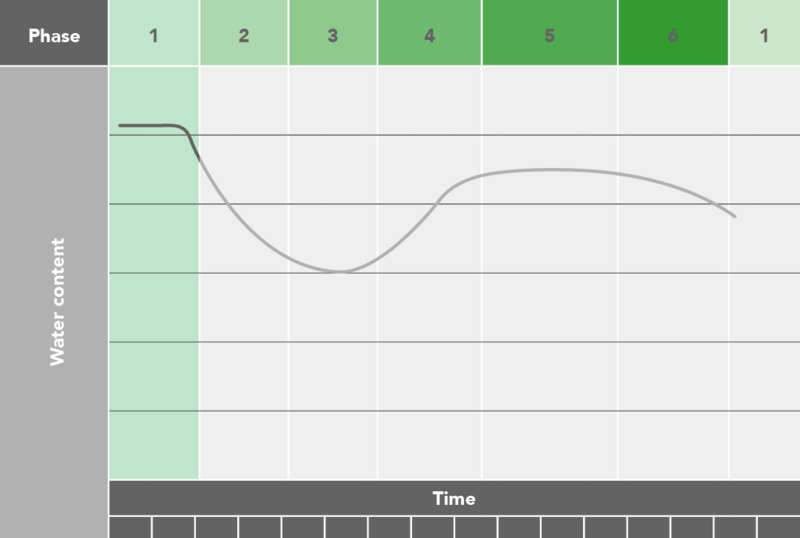
Start of phase
Plants arrive into the greenhouse
End of phase
When the roots have penetrated into the substrate several centimeters and water
absorption is no longer dependant on the moisture content in the block.
Objective phase
Fast and uniform rooting in, so that the roots are penetrating the growing media in line with the plant size.
Good water management is critica! for a successful crop. lt starts in this growth phase. Please pay attention to how you cut the drain hole.
Following initial saturation leave the slabs full for at least 24 hours before making the drain hole. In this way, the fine pores are also saturated, which enhances uniformity for the rest of the cultivation. The NG2.0 technology used in the slab in combination with Plantop blocks contribute to optimal uniformity over the entire height of the growing media and provides a perfect block-slab connection. This promotes uniform rooting in and thus uniform stem development.
For accurate EC control during the entire cultivation cycle we recommend you cut one drain hole at the lowest point in each slab. Make sure this is done properly, poorly cut drain holes will have a huge impact on your ability to steer the growing media WC% & EC. More than one drain hole will result in an uneven WC% & EC within the slab and will also make steering (WC% & EC) on irrigation session length (ml/m²) harder.
You have two options for cutting the drain holes
Option 1
Pre-draining the slab: Pre-draining the slab involves making a small puncture in the plastic wrapper just above the seam at the end of the slab. A uniform layer of water then remains in all slabs in the greenhouse. Following planting the remaining water is available and will be drawn into the Plantop blocks due to NG2.0 technology. This block - slab interaction means that in the first days after planting only 1 at most 2 irrigation sessions will be required to help stimulate rooting in. After 4 - 7 days when the young crop is rooted into the growing media the final drain hole can be cut. Watch the video below on how to do this correctly.

Option 2
Drain the slabs directly: lf the final drainage hole is cut before planting, 3 - 5 irrigations per day will be required until the plant is rooted 3 - 5 cm into the slab. Watch the video below on how to do this correctly.

lrrigation water seeks the shortest route towards the drain hole. Position the irrigation peg on the plant blocks (not too deep) so that they are as far away from the drain hole as possible. Remember the irrigation peg furthest from the drain hole will be the most efficient at replacing the old slab solution.
| Bright day - Vegetative steering | Dark day - Generative steering | ||||||
| Start time | First days during rooting in irrigate every 4.0 - 5.0 hrs (subject to way drain hole is configured, see tips) | First days during rooting in irrigate every 4.0 - 5.0 hrs (subject to way drain hole is configured, see tips) | |||||
| Stop time | Not applicable | Not applicable | |||||
| Target day level WC | For rooting in WC >75% | For rooting in WC >75% | |||||
| Target decrease WC overnight | Not applicable | Not applicable | |||||
| Moment 1st drain | Not applicable | Not applicable | |||||
| EC drip | 3.0 - 3.5 mS/cm | 3.0 - 3.5 mS/cm | |||||
| EC block | 3.0 - 3.5 mS/cm | 3.0 - 4.0 mS/cm | |||||
| 24 hr drain | Not applicable | Not applicable | |||||
| Irrigation volume | 100 - 125 ml/block | 100 - 125 ml/block | |||||
| ml/joule | Not applicable | Not applicable | |||||
| Night irrigation | If decrease >20% | If decrease >20% | |||||
Before planting it is essential that all slabs are fully saturated with complete nutrient solution. Thanks to the NG2.0 fibre of GT Master Dry this is an easy task. However we would advise that you wait at least 24 hrs following saturation before the drain holes are cut. To facilitate maximum generative - vegetative steering of WC% and EC in the root zone throughout the duration of the cultivation you are advised to cut one drain hole. Cutting along the full width of the plastic seam at the end of the slab is the ideal way to do this. Please see the instruction videos on how to do this optimally. Remember with GT Master Dry it is perfectly safe to recycle the drain water from the moment the drain holes are cut in the greenhouse. This will help reduce unwanted emission of fertilizer to the environment.
Target crop
Work on plant development and increasing the leaf area to capture the available radiation and keep the required vegetative – generative balance in the plant relative to the fruit load and light levels.
Target root zone
Establish complete root penetration in the entire volume of the growing media. This will enable the plant to take up all the water and nutrition it will need for maximum summer production and quality.
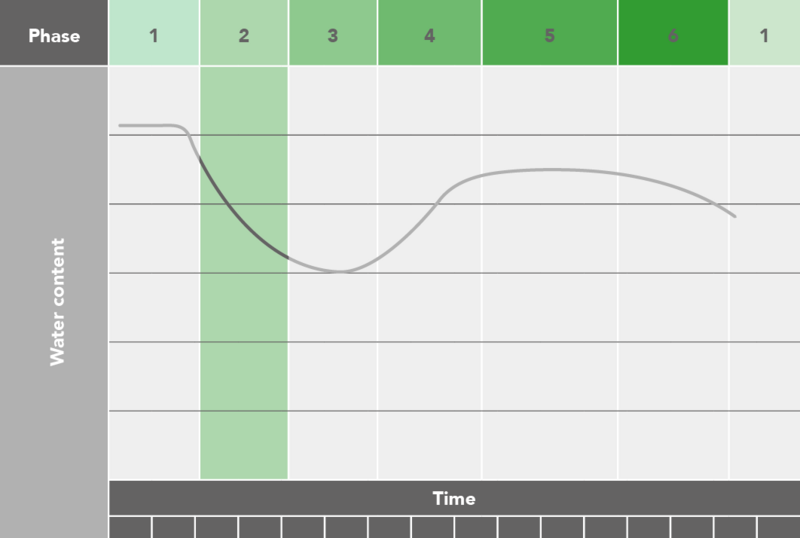
Start of phase
When the roots have penetrated into the substrate several centimeters and water absorption is no longer dependent on the moisture content in the block.
End of phase
When the plant starts to feel the effects of the fruit load following first setting.
Objective phase
Set the first fruits at the desired internode and continue their development and the realisation of a root system that fills the entire substrate volume.
The GroSens Sensor should now be inserted into the growing media. Ensure that the stainless steel plate on the sensor is at the correct height. The video below shows you where to place the sensor irrespective of crop type.
When the crop is rooting through the slab the evaporation by the plant is still very low. This means that up to ten days after planting the slab WC% will fall <1% per day even without irrigation. However for every additional 10 days of growth the decrease in WC% will be one percentage point higher so 20 to 30 days after planting the daily water uptake should be between 2% and 3% of the total slab volume.
As a general rule to ensure sufficient decrease in WC% overnight you can use the following formula to judge the start/ stop times of irrigation: there should be a minimum decrease of 2% starting from where the stem breaks to produce the final growing shoots and then for every 20 cm growth x 1 %. For example with a total plant height 130 cm with the stem break @ 30 cm = 2% + (5 x 1%) = 7% minimum decrease WC% overnight.

Aim for a slab WC% of 55-65% around the time of 1st setting measured at day level (highest value on the day). So plan the decrease now! lt is no issue that during this phase the slab EC increases to 5.0 - 6.0 mS/cm as the evaporation by the crop is very low.
In the first weeks of cultivation especially on the dark, inactive days’ irrigation can be skipped for several days at a time. Plan so that you irrigate on the brighter more ‘active’ days or days where higher pipe temperatures are required.
| Bright day - Vegetative steering | Dark day - Generative steering | ||||||
| Start time | +2.0 hrs after sunrise At least 1.0 hour after opening energy screen | +3.0 hrs after sunrise At least 1.0 hour after opening energy screen | |||||
| Stop time | -2.0 hrs before sunset At least 2.0 hours before closing energy screen | -3.0 - 4.0 hrs before sunset At least 2.0 hours before closing energy screen | |||||
| Target day level WC | Gradually decreasing to 60% at first fruit setting and increasing to 70% by the start of Phase 3 | Decreasing to 55 - 60% (min WC 50%) at first fruit setting and increasing to 65% by the start of Phase 3 | |||||
| Target decrease WC overnight | 3 - 5% depending on plant size | 4 - 6% depending on plant size | |||||
| Moment 1st drain | Not applicable | Not applicable | |||||
| EC drip | 3.0 - 3.3 mS/cm | 3.2 - 3.5 mS/cm | |||||
| EC block | 3.0 - 3.5 mS/cm | 3.5 - 4.5 mS/cm (go up to 4.5 mS/cm to stimulate fruit setting if needed) | |||||
| 24 hr drain | 15 - 25% | 0 - 15% | |||||
| Irrigation volume | 300 - 400 ml/m² i.e. 3 - 4% growing media volume/m² | 400 - 500 ml/m² i.e. 4 - 5% growing media volume/m² | |||||
| ml/joule | Not applicable | Not applicable | |||||
| Night irrigation | When average pipe temp > 60°C | No | |||||
The concept of Precision Growing combines variety, climate and irrigation strategies in an optimal way. In Phase 2 work on gradually reducing the day level WC% and increasing the growing media EC until first setting. lmportantly towards the end of this phase you will require minimal irrigation volumes to stabilize and refresh the EC of the growing media. Consequently “flushing” the growing media is not required, thereby you are able to facilitate maximum generative steering.
Target crop
Growth should remain constant and uniform. The 24 hrs temperature should be adjusted to the light levels to ensure optimum partitioning of available assimilates for plant and fruit growth.
Target root zone
Root quality and activity should be retained to ensure controlled and uniform re-growth of the crop from the harvest of the first flush until the second flush. The decrease of WC% during the night will provide a good indication for the level of plant activity during the day.
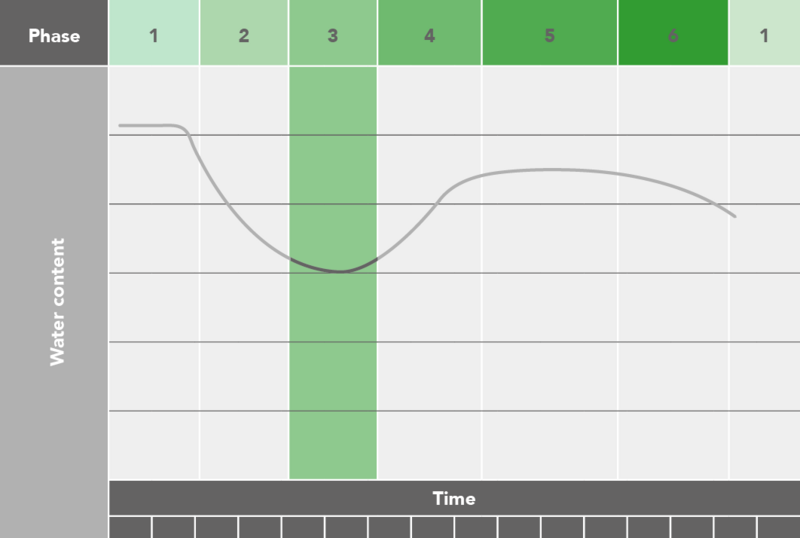
Start of phase
When the plant starts to feel the effects of the fruit load following first setting.
End of phase
Following the first harvest, when the pressure of the fruit load is starting to decrease.
Objective phase
Avoid shocks in development by retaining the right balance in fruit load and growing power in the plant for the second fruit setting. Combination of harvest of the first fruits and new fruit setting (fruit load increases) must be in line with assimilates supply which is variable and strongly depending on the weather.
During phase 2 the WC% of the slabs was lowered. ldeally by not irrigating on the dark ‘passive days’. This strategy should have resulted in complete rooting throughout the entire volume of the slab. The result is good overall crop development with increased generativity and a uniform 1st setting.
Now, at the moment of setting, daily irrigation is recommended it should consist of 1 or 2 ‘fixed’ sessions per day. You can also begin to start working with more structured start and stop times on the basis of radiation sum. However please note that radiation sum used to trigger an irrigation is not pushed too high in the afternoon in order to allow that extra session on sunny days. High EC values in the slab (5.0 - 6.0 mS/cm) are not a problem at this time of year as long as there is no ventilation and the transpiration of the crop is at a relatively low and stable level.

A high or increasing slab EC should not be the reason to lower the irrigation EC. First create additional drain volumes. However remember not to go ‘chasing drain’ and stimulating unwanted vegetative plant development. For example on the dark days drain is not necessary or at most 10 - 15%. Drain is only desirable on the sunny days and on these occasions it may be high (in percentage terms > 50%).
The use of a fixed plastic (foil) screen can lead to large differences in climatic conditions and water absorption of the crop which will result in differences in slab WC%. Map these differences per irrigation compartment by measuring a representative number of slabs in each valve section using the GroSens HandHeld Sensor and if necessary adjust the strategy to the observed differences per compartment.
| Bright day - Vegetative steering | Dark day - Generative steering | ||||||
| Start time | +2.0 hrs after sunrise 60 - 100 J/cm² or 200 W/m² | +2.0 - 3.0 hrs after sunrise | |||||
| Stop time | -2.0 hrs before sunset | -3.0 - 4.0 hrs before sunset | |||||
| Target day level WC | During first harvest 65%. By the start of the second harvest 70% | 60 - 65% | |||||
| Target decrease WC overnight | 6 - 7% | 7 - 8% | |||||
| Moment 1st drain | 400 J/cm² or 600 W/m² | Less than 4 irrigations | |||||
| EC drip | 2.7 - 3.0 mS/cm | 3.0 - 3.3 mS/cm | |||||
| EC block | 3.0 - 3.5 mS/cm | 3.3 - 3.8 mS/cm | |||||
| 24 hr drain | 20 - 30% | 10 - 20% | |||||
| Irrigation volume | 300 - 400 ml/m² | 400 - 500 ml/m² | |||||
| ml/joule | 2.5 ml/J (> 800 J/cm²) | Not applicable | |||||
| Night irrigation | Only if pipe temperature >60°C | Not applicable | |||||
The growth of new roots and root tips should be encouraged by adjusting the start and stop times of irrigation, especially on darker days. The confidence to steer the slab to a low day level WC% is made possible due to the uniformity of WC% & EC over the height of the growing media. The drip and slab EC’s are important steering tools to maintain plant balance and fruit quality in this phase. The NG2.0 technology allows the drip EC to be maintained sufficiently high while the slab EC remains stable with minimal drain volumes. This makes it possible to start irrigation later and stop earlier especially on the darker days. lmportantly it means that you do not have to “chase” growing media EC by applying additional irrigation water and creating unnecessary and unwanted vegetative crop development.
Target crop
Prepare the crop for summer creating the right balance as the plant load and production continue to increase.
Target root zone
To support increasing transpiration levels the root zone environment needs to be prepared. The recommended WC% and EC levels for late spring and summer should now be realised.
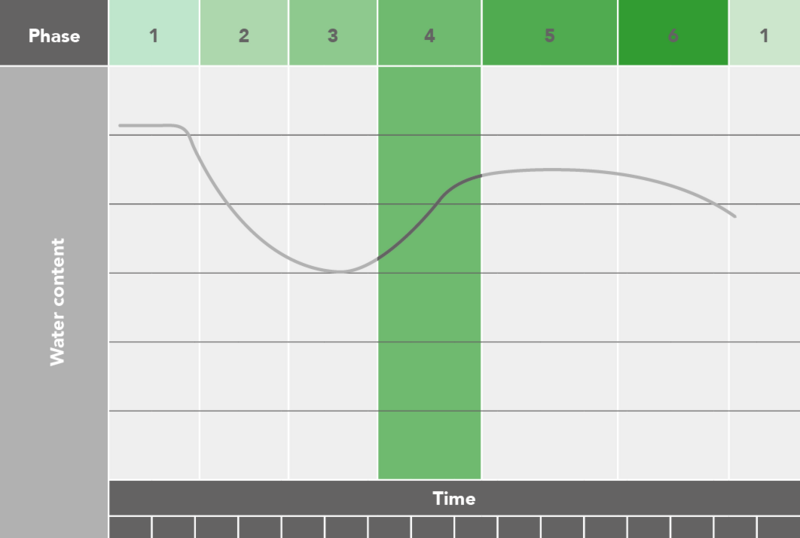
Start of phase
Following the first harvest, when the pressure of the fruit load is starting to decrease.
End of phase
When production levels are stable
Objective phase
Realise controlled and uniform re-growth of the crop until harvest of the second flush.
First harvests have now been taken and solar radiation is increasing rapidly towards the longest day. From now on the irrigation strategy can become more structured. Remember there are 4 key irrigation stages during the day:
| Bright day - Vegetative steering | Dark day - Generative steering | ||||||
| Start time | +2.0 hrs after sunrise 70 - 100 J/cm² or 200 W/m² | +2.0 - 3.0 hrs after sunrise When WC% falls 1.5 - 2.0% from sunrise | |||||
| Stop time | -2.0 hrs before sunset Ideally leaving or 70 - 150 J/cm² and a light intensity threshold 200 - 300 W/m² to sunset | -3.0 - 5.0 hrs before sunset | |||||
| Target day level WC | Increasing to 70 - 75% | Gradually increasing to 70% | |||||
| Target decrease WC overnight | 7 - 8% | 8 - 9% | |||||
| Moment 1st drain | 400 J/cm² or 600 W/m² | Less than 4 irrigations | |||||
| EC drip | 2.8 - 3.0 mS/cm | 3.0 - 3.3 mS/cm | |||||
| EC block | 3.0 - 3.5 mS/cm | 3.3 - 3.8 mS/cm | |||||
| 24 hr drain | 25 - 30% | 15 - 25% | |||||
| Irrigation volume | 250 - 350 ml/m² | 350 - 450 ml/m² | |||||
| ml/joule | 2.5 - 3.0 ml/J | 2.5 - 2.8 ml/J | |||||
| Night irrigation | If decrease WC% >10% | No | |||||
The excellent re-saturation characteristics of GT Master Dry mean that the start time of irrigation can be delayed in line with plant activity especially on dark days. Drain can still be achieved in time to stabilise the EC of the growing media using larger irrigation sessions in the morning. This will maintain optimum fruit quality. Vegetative steering on bright days will encourage the crop to grow optimally for maximum production. The start time of irrigation should now be related to the light sum (J/cm²) or the light intensity (W/m²) on bright days.
Target crop
Vegetative or generative steering will depend on the condition of the crop. The crop should remain strong to cope with large and extreme fluctuations in weather conditions. The set speed should match the harvest speed to maintain constant fruit load.
Target root zone
Water uptake should match the needs of the crop for maximum cooling potential to create a good climate inside the greenhouse. Good root penetration throughout the entire volume of the growing media realised in Phase 2 will help the crop to cope with extreme weather conditions.
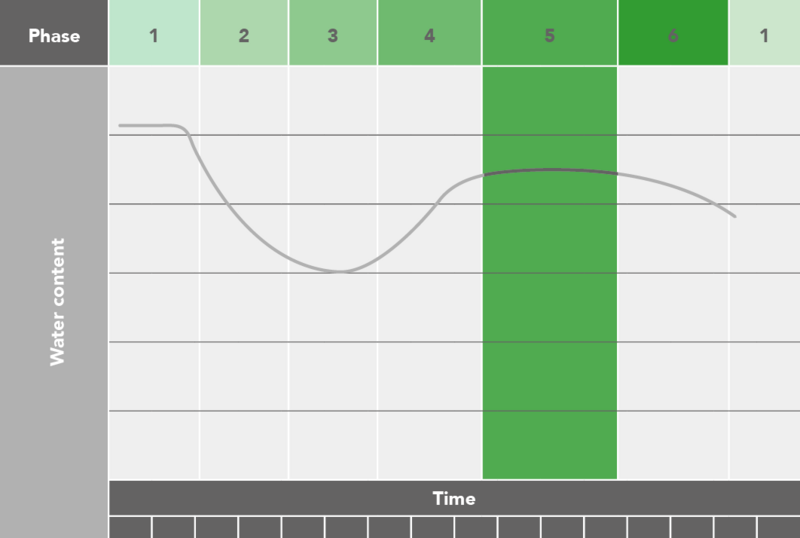
Start of phase
When production levels are stable.
End of phase
The last setting
Objhective phase
Maintain maximum plant vigour and production potential by keeping plant and root quality in excellent health.
Start and stop times should coincide with plant transpiration. lt is best to remove the maximum rest time setting from the first irrigation period and use a light only setting (see advice tables). The second irrigation period should contain a maximum rest time setting. Likewise the final irrigation period of the day should be based on light only starts. In this way on a dark day no starts will be given and on a bright day the starts continue (see advice table) and a stable decrease in WC% will be maintained.
The irrigation EC should remain >3.0mS (especially with radiation <600W/m²). The good irrigation efficiency of the Grodan slabs means you do not have to chase the EC of the growing media and can therefore keep irrigation under control especially in periods of changeable weather. A light reduction EC setting can be used but watch that you do not make the range too reactive, respecting the planned stop conditions.
An increasing EC at midday will have consequences for the plant’s vigour and fruit quality (micro-cracking and blossom-end-rot if it is not controlled). In the morning start with larger irrigation volumes 4 - 5% of the volume of the growing media in order to get drain in time. In the afternoon shorter more frequent irrigations 3% of substrate volume will help keep slab WC% & EC stable and controlled.
The GroSens system is an excellent tool to assess if the irrigaiton strategy needs adjusting. The standard graphic on your climate computer should contain WC%, EC, radiation sum (J/cm²) and radiation intensity (W/m²). lf scaled correctly it is very easy to see relationships between these data points and answer the following questions:
| Bright day - Vegetative steering | Dark day - Generative steering | ||||||
| Start time | +2.0 hrs after sunrise 70 - 100 J/cm² or 200 W/m² | +2.0 - 3.0 hrs after sunrise When WC% falls 1.5 - 2.0% from sunrise | |||||
| Stop time | -2.0 hrs before sunset Ideally leaving or 70 - 150 J/cm² and a light intensity threshold 200 - 300 W/m² to sunset | -3.0 - 5.0 hrs before sunset | |||||
| Target day level WC | 75% | 70 - 75% | |||||
| Target decrease WC overnight | 7 - 8% | 8 -9% | |||||
| Moment 1st drain | 400 J/cm² or 600 W/m² | Less than 4 irrigations | |||||
| EC drip | 2.6 - 3.0 mS/cm | 2.8 - 3.2 mS/cm | |||||
| EC block | 3.0 - 3.5 mS/cm | 3.3 - 3.8 mS/cm | |||||
| 24 hr drain | 25 - 35% | 20 - 25% | |||||
| Irrigation volume | 300 - 350 ml/m² | 350 - 450 ml/m² | |||||
| ml/joule | 2.5 - 3.0 ml/J (depends on use of shading) | 2.5 - 2.8 ml/J | |||||
| Night irrigation | If decrease WC% >10% | Not applicable | |||||
The strong root system formed in previous phases should benefit the crop when transpiration is highest thus promoting strong growth and facilitating optimum production and quality. The first drain on bright days should coincide when the outside radiation reaches 600 W/m² or light sum accumulation equates to 400 J/cm² as this will ensure EC is stabilized within the growing media when the light intensity is at its peak.
Target crop
Maintain strength and growing power of the plant and limit the ingress of disease in the crop as the light levels diminish towards final harvest.
Target root zone
Maintain a healthy and active root system and to keep the correct nutrient balance in the root zone. Ensure the irrigation strategy compensates for the rapidly changing transpiration levels. Maintain a stable and sufficient decrease WC% during night.
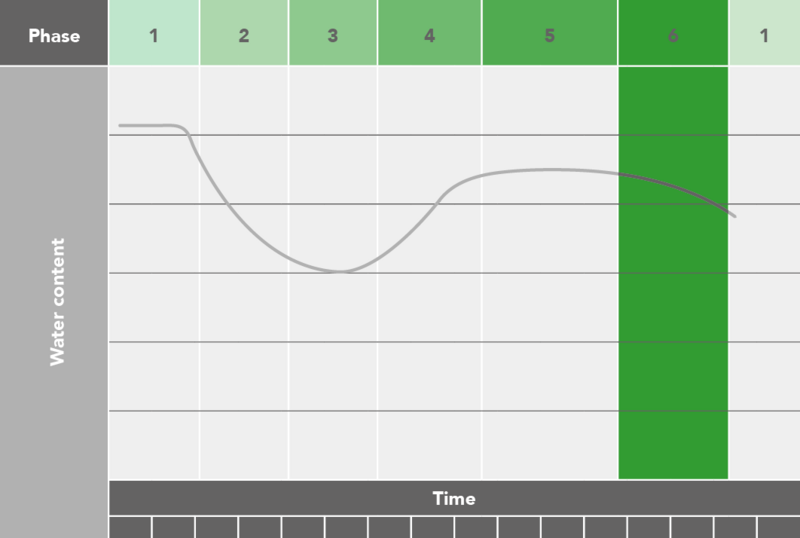
Start of phase
The last setting.
End of phase
When final harvest has taken place.
Objective phase
Keep the crop in a healthy condition and use the vigour to ensure production and quality is maintained right through to the last planned harvest date.
In order to keep the root system healthy good oxygen penetration is important. Therefore lower the irrigation frequency and the day level slab WC% will decrease slowly. To compensate for the lower irigation frequency increase the size of the irrigation volume per cylcle. Ensure the start and stop times coincide with the astronomical clock and gardually lower the day level slab WC%.
Pay attention to dark days with relatively high temperatures as the crop can evaporate more than the anticipated set radiation sum. On a sunny autumn day, the crop will only become active at +/- 100 J/cm². This is the moment for the 1st irrigation.
Often too much irrigation is given on dark days. The advice is to irrigate with minimum volumes on days >500 J/cm² and it is neither uncommon nor detrimental to the crop to achieve zero drain and let the growing media EC increase. On days where the radiation sum exceeds 1000 J/cm² irrigation should be applied 2.5 to 3.0 times the radiation sum. Such days are appropriate for leveling slab EC between 11:00 – 13:00 hrs.
Stop irrigation on dark days up to 3.0 - 4.0 hrs before sunset and target a steady decline in slab WC% overnight between 7 - 8%. Overall keep the irrigation EC >3.0 mS/cm especially when radiation <600 W/m² and consider the need for light reduction EC if these settings have been very reactive during phase 5.
| Bright day - Vegetative steering | Dark day - Generative steering | ||||||
| Start time | +2.0 hrs after sunrise 80 - 100 J/cm² or 250 W/m² or decrease WC% after sunrise 1.0 - 1.5% | +2.0 - 3.0 hrs after sunrise or at decrease WC% 1.5 - 2.0% | |||||
| Stop time | -2.0 hrs before sunset Ideally leaving 80 - 100 J/cm² and a light intensity threshold 250 - 300 W/m² to sunset | -3.0 - 4.0 hrs before sunset | |||||
| Target day level WC | Decreasing from 70 - 75% at final setting to 60 - 65% as the fruits develop | Decreasing from 70% at final setting to 60% as the final fruits develop | |||||
| Target decrease WC overnight | 8% | 8 -10% | |||||
| Moment 1st drain | Within 4 irrigations before reaching 400 J/cm² or 600 W/m² | If desired within 5.0 hrs after sunrise or after 3 irrigations | |||||
| EC drip | 2.8 - 3.0 mS/cm | 3.0 - 3.3 mS/cm | |||||
| EC block | 3.0 - 3.5 mS/cm | 3.5 - 4.5 mS/cm | |||||
| 24 hr drain | 20 - 30% | 10 - 20% | |||||
| Irrigation volume | First 3 - 4 irrigations 400 - 500 ml/m² then go back to 300 - 400 ml/m² | 400 - 500 ml/m² | |||||
| ml/joule | 2.6 - 2.8 ml/J | Not applicable | |||||
| Night irrigation | No | No | |||||
As the outside climate becomes increasingly vegetative the day level WC% in GT Master Dry should be decreased gradually. This is readily achieved due to the dry nature of the slab and with attention to the start-stop of irrigation. A stable decrease of WC% during the night is most important. On the darker days target a larger decrease in WC% to protect root quality and keep the right generative balance in the crop. Under these circumstances the EC can be stabilised using large irrigation volumes. The fast re-saturation properties of GT Master Dry will mean day level WC% can easily be increased to ensure enough water and nutrition is supplied to the heads on the bright days.
We are a global leader in the supply of innovative stone wool substrate solutions for the professional horticultural based on Precision Growing principles.